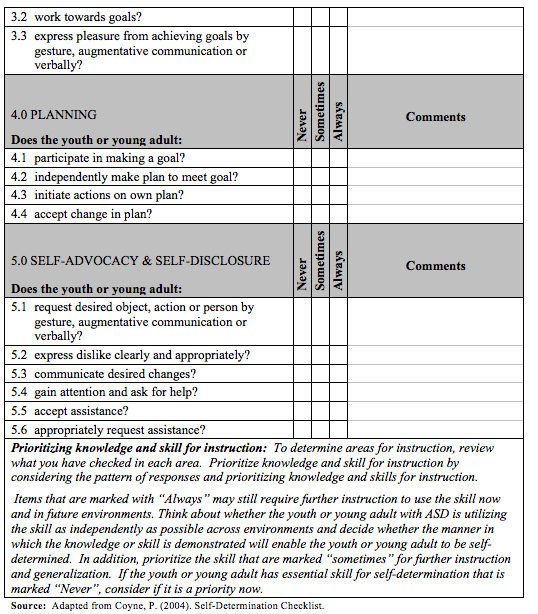-

Preparing Youth with Autism Spectrum Disorder for Adulthood A Transition Toolkit for Educators
UNIT 3.5: Self-Determination
Key Questions
- What is self-determination?
- Why teach knowledge and skills in self-determination to youth with ASD?
- What core skills are necessary to be self-determined?
- Do all youth with ASD need knowledge and skills in self-determination?
- When should I start teaching self-determination?
- Does my student with ASD really need to know about his disability?
- How do I determine what self-determination knowledge skills to teach?
- Are there self-determination curriculum or lesson plans I can use with my student(s) with ASD?
- How should I teach delf-determination skills?
- How can I involve my students with ASD in developing their own IEPs and Transition Planning?
- How do I evaluate the effectiveness of instruction in self-determination?
Appendices
- Appendix 3.5A: Online and Other Resources
- Appendix 3.5B: Checklists
- Appendix 3.5C: Supplemental Instructional Materials for Self Knowledge, Goal Setting and Self-Disclosure
By Phyllis Coyne
Although most educators agree that self-determination is important for students with ASD, it may be challenging to find the time and resources to provide instruction in this area. The information and practical resources in this unit of Unit 3: The Expanded Core Curriculum are designed to help educational staff to provide self-discovery, structured learning activities and a cumulative understanding of the many facets of self-determination for youth and young adults with ASD.
Please be aware that self-determination for youth with ASD is integrally interrelated with the other domains in Unit 3. Self-determination can only be achieved with careful attention to the four areas of the expanded core curriculum that address the underlying characteristics of ASD. These include Unit 3.1: Communication, Unit 3.2: Social Skills, Unit 3.3: Executive Function/Organization, and Unit 3.4: Sensory Self-Regulation. (You will need to scroll down to Preparing Youth with Autism Spectrum Disorder for Adulthood).
This is a resource for you and is designed so that you can return to sections of this unit, as you need more information or tools. You do not need to read this unit from beginning to end or in order. Feel free to print this unit for ease of reading or as an accessible reference. You will get the most from this unit by also using the online features. Links to questions, appendices and online resources are provided so that you can go directly to what is most relevant to you at the time.
What is self-determination?
This toolkit utilizes the term self-determination to refer to the ability of individuals to know themselves, control their lives, plan and reach their goals and self-advocate. According to Field, Martin, Miller, Ward, & Wehmeyer (1998), self-determination consists of the skills, knowledge, and beliefs needed to engage in goal-directed behaviors based on an understanding of one’s strengths, limitations, and self. One student more succinctly defined it as “putting feet on my dreams” (Fullerton & Coyne, 1999).
Why teach knowledge and skills in self-determination to youth with ASD?
Instruction in self-determination is now widely recognized in the literature as a best practice procedure in the education of students with disabilities, particularly regarding facilitating students’ involvement in their IEP and transition planning (e.g. Cobb, Lehmann, Newman-Gonchar, & Alwell, 2009; Hasazi, Furney, & DeStefano, 1999; Stodden, Galloway & Stodden, 2003;; Schall, 2009; Thoma & Wehmeyer, 2005; Williams-Diehm & Lynch, 2007). Learning to become self-determined increases the control students experience over their education and transition outcomes (Mithaug, Mithaug, Agran, Martin, & Wehmeyer, 2003). With self-determination skills youth are able to articulate career goals, strengths, and interests, as well as reach out for assistance in order to benefit from support services (Lindstrom, Paskey, Dickinson, Doren, Zane, & Johnson, 2007).
Self-determination is necessary for adult life, because the mandated services under IDEA for individuals with disabilities, including ASD, end at graduation or at age 21. After leaving school services under IDEA 2004, obtaining needed accommodations becomes a self-initiated process under the Americans with Disabilities Act (ADA) and Section 504 of the Rehabilitation Act. In adult life individuals with ASD must request the supports that they need.
Students with ASD need explicit instruction in order to learn the important skills of self-determination. Unlike their neurotypical peers, youth with ASD do not naturally learn how to be self-determined through observation, practice, and self-reflection. Without self-determination training, youth with ASD are usually unaware of their own strengths and weaknesses, so they cannot advocate for themselves.
Positive Adult Outcomes
Enough studies have demonstrated the benefits of self-determination that the National Secondary Transition Technical Assistance Center (2009) has determined that self-determination is an evidence-based predictor of post-school employment and education. Students who are expected to take responsibility for planning their transitions and who are trained to engage in self-determination activities early in secondary school have been shown to take greater responsibility for their lives after school (deFur, 2003). In a 20-year longitudinal study, Goldberg, Higgins, Raskind, & Herman (2003) found that self-determination attributes predicted post high school success. The relationship between self-determination and positive transition outcomes prompted the Council for Exceptional Children’s Division on Career Development and Transition to call for the inclusion of self-determination instruction to prepare students for their transition from high school (Field, Martin, Miller, Ward, & Wehmeyer, 1998).
Improved Employment Outcomes
Success in employment has been shown to be more prevalent in those with self-determination skills. In studies by Wehmeyer & Schwartz (1997) and Wehmeyer & Palmer (2003), students with cognitive disabilities and learning disabilities who had higher levels of self-determination had higher employment rates. Martin, Mithaug, Oliphint, Husch, & Frazier (2002) found that workers with disabilities who completed a self-determination and job placement program kept their jobs significantly longer than those who only completed a job placement program.
Need for More Instruction
A large majority of students with ASD graduate from public schools lacking education in self-determination, rendering them unable to successfully advocate for themselves. This lack of knowledge can cause adults on the spectrum to have significant difficulty in the adult domains of higher education, employment, relationships, and other areas of life.
Self-determination is critical to increasing the odds of a successful transition to adulthood (Harrington, 2008; Held, Thoma & Thomas, 2004; LaCava, 2005). Educators should teach self-determination to youth with ASD. It is a necessary part of their education, if they are to have a more meaningful and satisfying adult life.
What core skills are necessary to be self-determined?
Many programs in self-determination contain content and practice in self-knowledge, goal setting and self-advocacy. These areas are equally important for students with ASD. In addition, the areas of choice-making, self-knowledge related to ASD and knowledge of rights and responsibilities are critical to enable youth and young adults with ASD to gain the necessary self-awareness and self-directed actions needed for self-determination.
For youth and young adults with ASD, self-determination requires knowledge and skills in:
- Choice making: expressing own preferences, selecting objects and actions, and making own decisions.
- Self-knowledge: understanding interests, strengths and challenges; knowing how ASD affects performance; and knowing what accommodations work for them
- Goal setting: identifying goals that match talents and interests in present and future.
- Planning: identifying steps and developing implementation plans for accomplishing goals.
- Self-advocacy: knowing when and how to approach others in order to negotiate desired accommodations.
- Knowledge of rights and responsibilities related to IDEA, ADA, Section 504, and adult services.
Do all youth with ASD need knowledge and skills in self-determination?
Yes. Self-determination is for everyone. The freedom, control and responsibility inherent in self-determination are essential rights for all individuals. Self-determination plays a vital role in nearly every aspect of life for an individual with ASD, in school, at home, in the community and at work. Individuals with ASD, regardless of their cognitive level or severity of ASD need self-determination skills.
Youth with Significant Cognitive Challenges
Many people presume that youth and young adults with ASD who have significant cognitive challenges cannot be self-determined. However, given adequate supports, opportunities to experience control by having one’s preferences honored, chances to learn to make choices, and opportunity to learn skills related to self-determination, they can become self-determined in their own way. According to Turnbull & Turnbull (2001) and Wehmeyer (1998), self-determination is as relevant and obtainable for individuals with significant intellectual disabilities as for anyone else.
The educational literature has primarily addressed the abilities of those with severe cognitive challenges to make choices and express preferences for self-determination. While choice making will be addressed below, keep in mind that self-determination goes beyond expressing preferences and making choices. The person-centered future planning procedures have shown that youth and young adults with significant disabilities can be involved in the decision-making process, including making decisions about their own lives.
Choice Making
Individuals with disabilities frequently refer to the opportunity to make choices as an important part of the right to self-determination. Choice is critical to the quality of life for all of us. Choice making can reduce problem behaviors, increase motivation and develop personal freedom for individuals with disabilities. In addition, choice making skills provide building blocks upon which other areas of self-determination and independence are based, such as decision-making, planning, and self-management.
Instruction in self-determination must start early in life for students with ASD to identify their own preferences, based on their unique interests and abilities, and allow them opportunity to select activities based on preferences. Instruction in self-determination may start with basic choices, such as choosing what to eat or what to do during free time, by using a choice board of pictures or real objects. Further development of choice making skills can enhance the ability to make choices of foods, clothing, activities, employment, residence, roommates, and other areas of life. Similarly, choosing activities for the day may start with teaching how to use a schedule starting with a predetermined “first, then”, then progressing to choosing one’s own “first, then.” An important and often overlooked aspect of choice making and self-advocacy that should be taught is expressing dislike clearly and appropriately. Additional information on developing choice making skills in students with ASD can be found in the Autism Internet Modules under Behavior Interventions.
Those most impacted by ASD may not be able to take full control of decisions that impact their lives. Significant cognitive challenges effect the ability of an individual to be self determined without extensive support of other people. They should be assisted to choose to the extent that they are able. Educators can do things to support, promote, and enable self-determination. Carefully planned instruction and adaptive technologies will enable youth with ASD to be self-determined in their own way.
All of us are interdependent and relinquish control to others who are more capable than we are in specific areas, such as financial planners and doctors. Part of self-determination for those most affected by ASD may involve choosing whom to depend on for decision making support, or "translating" and interpreting their needs and desires. Families, friends and professionals who make decisions and act for the youth, based on a well founded belief of what decisions he would make, given his values, strengths, preferences, interests and needs, if he had the cognitive ability necessary to make more complex decisions, assist the individual to be self determined. This type of person centered planning is critical to a quality of life consistent with the individual’s own values, preferences, strengths and needs. More information on person centered planning may be found in Unit I: Transition Planning and Services of this toolkit.
When should I start teaching self-determination?
Self-determination develops over time and instruction in self-determination should start as soon as possible. Generally, the best time to start teaching the concepts of self-determination is when it is first learned that the child has ASD and is considered to be in need of special education services. Self-determination begins with the smallest parts of every day life, e.g. deciding what to have for lunch or deciding what to do with free time. Overtime, self-determination expands to long term goals, such as "What type of job do I want to have?” or “Where do I want to live when I'm an adult?" If we want youth with ASD to leave school services being able to describe their needs, interests, skills, supports, accommodations and advocate for themselves, we cannot wait until the final years of school to provide instruction.
Does my student with ASD really need to know about his disability?
Yes. Understanding one’s disability in relationship to oneself is an important part of self-determination. Although the depth of understanding and knowledge will vary depending on the cognitive abilities of the individual, every student with ASD needs to be given the opportunity to know how ASD uniquely affects him to determine what helps and to become an effective self-advocate. The young person will need to self disclose his disability, if he wants to request accommodations at work, postsecondary education/training, and in community activities. He needs to know about his disability to do so.
Educators or parents may be reluctant to teach a student with ASD about his disability, because they fear that the student will use it as an excuse. Most of us have heard or heard of students who say “I can’t do it because I have autism”. We may also have known or heard of students who indiscriminately announce “I have autism”. This is generally a result of being given a label without a full understanding of how it applies to them, what they can do about it, and when it is advisable to disclose. These types of self defeating statements can be avoided by systematic instruction about 1) how ASD affects learning and functioning, 2) strategies that will help, and 3) appropriate self-disclosure.
Eric is an example of an intelligent young man who almost lost his job as a computer draftsman, because he did not understand his ASD beyond the label. He did not understand that he was very light sensitive or that he had developed ways to cope with his light sensitivity, such as wearing a baseball cap, wearing sunglasses, and keeping rooms dark. He just did them automatically. In the office that he shared with his boss, he repeatedly closed the shades and turned off the flickering fluorescent lights when his boss was not in the room to insist that there was light in the room. His boss became increasingly upset that the room would be dark when he returned, despite directions he gave to leave lights on. Eric was totally baffled by his boss’ growing agitation, since he did not realize that his school had accommodated his light sensitivity by allowing him to wear hats in school, provided preferential seating away from windows and provided a halogen lamp. He did not realize that he needed accommodations. His boss, who Eric could not tell about a disability he did not understand himself, erroneously thought, if Eric could not follow a simple direction like “Leave the lights on”, Eric was unlikely to accurately follow directions to do his work. His boss also thought it was odd that Eric wore either a baseball cap or sunglasses to meetings and wondered if Eric was trying to hide something. This confusion and frustration could have been avoided if Eric had known how Asperger’s Syndrome affected him and been able to advocate for what he needed.
When instruction related to ASD is provided in a planned, sequential manner, youth and young adults with ASD are:
- Often relieved that there is a name for what they experience
- Often reassured that they are not alone in their experiences and are not to blame
- Enabled to define what ASD means to them
- Encouraged to see themselves as having glitches that they can do something about
- Assisted in learning what has worked well for others and themselves
- Prepared to advocate for themselves at school, work and in the community
When one student learned about his ASD, he said, “I always knew that I was different from other people, but I didn't know the whole story until just recently. Now I'm happier.” (personal communication, 2010).
Often educators and parents are not sure when to start teaching a student about their ASD. It is never too early to start understanding strengths, weaknesses and what helps. Most students with ASD can begin to learn about their disability while in elementary school. However, it is important to thoughtfully decide when to begin adding terms, such as autism, Asperger's Syndrome or autism spectrum disorder. In general, a good time to add the terminology is when a student shows interest in why he has differences, but not later than 5th grade. Readiness to know about ASD may be shown by comments, such as “I know I am different, but I don’t know why.” or “I know there is something wrong with me, but I don’t know what.”
Before terminology is introduced students can learn at their developmental level about their individual characteristics, such as their interests, what they are good at, what is hard for them and what helps them. This includes those most impacted by ASD. Students with mild cognitive challenges and above can also get grounded in concepts, such as, “Kids are different in many ways. Everyone is good at some stuff and not so good at other stuff. Everyone needs help at times.” They can learn about how ASD affects them in these areas as they start asking questions about their differences. As they become older, they can then learn more about their personal experience of ASD and what accommodations work for them.
Educators who want to promote an understanding of ASD in their students may not always have the tools they need. This unit contains a variety of resources for you to use. Appendix 3.5C: Supplemental Instructional Materials includes lesson plans for learning about one’s ASD. In addition, some useful books with lesson plans on teaching about ASD can be found under Practical Books Available on Loan in Appendix 3.5A: Online and Other Resources. Unit 1 and 2 in My Journey of Self-Discovery: A Self-Advocacy Curriculum for Students with Autism Spectrum Disorder provides lesson plans for learning about ASD and how it affects them.
One effective means of teaching about ASD is through personal accounts of youth and young adults with ASD. Appendix 3.5A: Online and Other Resources provides resources for personal accounts by youth and young adults with ASD. Links to free videos of youth and young adults talking about their experience of ASD is provided under Online Videos: Personal Experience of ASD. Additional link to personal accounts are provided under Self-Advocacy/Social Networking.
How do I determine what self-determination knowledge and skills to teach?
Instruction in self-determination needs to be individualized, because ASD is complex and youth with ASD have varying levels of self-determination. Gathering information about the youth’s pattern of strengths and weaknesses in self-determination knowledge and skills is key to establishing goals and how to teach them. This will save time and frustration for both the student with ASD and educators who want to promote the development of competencies in self-determination.
A good assessment of self-determination knowledge and skills collects information from a variety of sources and utilizes the information from ongoing age appropriate transition. (See Unit 1: Transition Planning and Services for information about transition assessment.)
There are two types of formal assessments of self-determination: independent, standardized assessments and pre- and post-curriculum assessments that are part of a published curriculum. Among the best known of standardized assessments is the Arc Self-Determination Scale, a 72-item, self report scale for students who are able to read or respond to questions to assess their own level of self-determination (Wehmeyer & Kelchner, 1995). (In addition to the student version, there is an adult version available from the publisher.) For students who are not able to respond to written or verbal questions, teams might use the American Institutes for Research Self-Determination Scale (Wolman, Campeau, DuBois, Mithaug, & Stolarski, 1994).
There are a few commercially available curricula that include pre- and post-test criterion-referenced assessments. Some examples of these are:
- Steps to Self-Determination: A Curriculum to Help Adolescents to Achieve Their Goals (Field & Hoffman, 1996)
- Next S.T.E.P. (Student Transition and Educational Planning) Curriculum (Halpern, Herr, Doren, & Wolf, 2000))
- ChoiceMaker: A Comprehensive Self-Determination Transition Program (Martin & Marshall, 1995)
Despite careful attention to address the self-determination needs of students with intellectual disabilities, these curricula still m any not meet the needs of students with ASD, particularly those who have additional disabilities or sever communication challenges.
Most assessment for self-determination is informal, such as observation and checklists. Checklists are quick assessments that help identify areas of knowledge and skill needed by youth for self-determination. They provide information from the people who know the youth the best, including the youth, family and school staff. The Self-Determination Checklist for Youth with ASD and the Self-Determination Checklist for Youth with ASD and Significant Cognitive Challenges are available for your use in Appendix 3.5B.
More self-determination assessment tools designed for use with those with disabilities, but not specifically for those with ASD, are provided in Appendix 3.5A under Assessment. Although these assessments can help you determine what to teach, be aware that they do not assess for all the areas of knowledge and skills suggested in this unit, such as own experience and knowledge of ASD. If you are not familiar with special considerations in assessment of youth with ASD, it is recommended that you read the section on assessment in Unit 1: Transition Planning and Services.
To determine areas for instruction from each of these assessments, review what you have checked in each area. Prioritize knowledge and skill for instruction by considering the pattern of responses and prioritizing knowledge and skills for instruction. Think about whether the youth with ASD is utilizing the knowledge and skill as independently as possible across environments and decide whether the manner in which the knowledge or skill is demonstrated will enable the youth to be self-determined in further education, employment and independent living.
The focus for youth with significant cognitive challenges will be more on the demonstration of skills, while those with better cognitive abilities require a balance of knowledge and skills. Some youth may require extensive support.
Are there any self-determination curriculum or lesson plans I can use with my student(s) with ASD?
Becoming self-determined is a process rather that curriculum. However, curriculum can focus sequential instruction. There are few self-determination programs developed specifically for those with ASD. The following two self-determination curriculum and one social skill manual with self determination elements were developed in Oregon for higher functioning youth and young adults with ASD.
My Journey of Self-Discovery: A Self-Advocacy Curriculum for Students with Autism Spectrum Disorder(Swedlund, Raiche, & Harris, 2005) is a self-determination curriculum, which includes both instructor and student materials. The curriculum, which consists of 12 units, was designed to be taught in individual or small group (2 - 4) settings in 30-minute sessions. Some key units of this curriculum include:
- What is my learning style?
- What are my rights and responsibilities under disability law?
- What does ASD look like in me?
- What is an IEP?
- How can I be an effective self-advocate?
- How do I effectively communicate information about my needs & myself?
- Celebrating successful self-advocates
'Putting Feet On My Dreams': A Program in Self-Determination for Adolescents and Young Adults (Fullerton, 1994) is a self-determination program designed and field-tested with higher functioning adolescents and young adults with ASD in high schools and continuing education classes in Oregon. The lessons can be taught as a separate class or integrated with another class, e.g. communication skills, social skills, life skills, study skills, coping skills, consumer education, health & family, and career awareness.
The Self Folio (Fullerton, 1994) is an adjunct to Putting Feet on My Dreams.
Putting Feet on My Dreams has seven units with lesson plans of 45 – 90 minutes, which are initially taught in a small group. These units are divided into three curricular themes: self-knowledge, life knowledge and life planning.
Appendix 3.5C provides some supplemental instructional materials for Putting Feet on My Dreams not currently in the program. Information about instructional strategies and supports used with Putting Feet on My Dreams is not provided within the curriculum. Descriptions of supports utilized to teach this curriculum is given in the article, Developing Skills And Concepts For Self-Determination In Young Adults with Autism (Fullerton & Coyne, 1999). This article can be accessed through an online research database, such as EBSCO, at your school district’s professional library or your public library.
MAAPSS: Manual For Adolescents With Asperger’s Piloting Social Success (Hass, 2004) is a manual that provides visuals for instruction in self-determination as part of social skills in Section 10: Organizational Visual Exercises. The following areas are covered on the pages indicated: Self Knowledge (pp. 103 - 104), Goal setting (pp. 93 & 97) and Planning (pp, 86, 87, 90, 92 & 96).
The instructional materials, specific to individuals with ASD, in this toolkit will not meet the needs of all students with ASD. Some educators have successfully used the instructional materials presented above to instruct youth with ASD who have mild to moderate cognitive challenges, although these programs were developed for higher functioning youth and young adults. Educators promoting self-determination to those most affective by ASD will find more practical information in the websites with asterisks in Appendix 3.5A. In addition, excellent information on instruction in choice making is provided in the Autism Internet Modules under Behavior Interventions.
In most cases, additional instructional material will be necessary to instruct beyond a year. Since it takes years to become self-determined, the content should be expanded in subsequent years. Other curriculum and instructional materials in self-determination for students with disabilities can be used to expand instruction and dozens of curricula have been developed to enhance self-determination for students with disabilities. Appendix 3.5A provides links to a variety of free curricula and lesson plans under Instructional Material. The Self Determination Synthesis Project provides a chart of both commercially available and free self-determination curricula. If you use these materials, remember that it is critical to ensure that the learning style and support needs of youth with ASD are addressed. Unit 2: Supports provides information on appropriate supports.
How should I teach self-determination skills?
The instructional methods and content will depend on the needs of the individual student. In general, youth with ASD learn best when educators use instruction that:
- Systematically teaches self-determination concepts and skills
- Provides needed supports
- Offers a combination of individual instruction and small group instruction
- Guided practice in real life situations provides guided practice and extensive opportunities to practice skills in real life situations
- Active involvement of the student
Systematic Teaching and Supports
The assessment and curricula inform the content for teaching self-determination. Assessment guides what underlying characteristics of ASD need to be supported during instruction for an individual. However, there are also evidence-based strategies that can be reliably used in small group and class instruction.
The vast majority of youth with ASD are visual learners and visual supports are an evidence-based practice. Visually organized information helps promote understanding and provides a permanent record of information. Some effective visual supports utilized with Putting Feet on My Dreams include:
- Graphic organizer that shows students where each class session fits within the program
- Development of graphic organizers and/or drawings to define and enhance understanding of new concepts as they are taught and discussed
- Graphic organizers, drawings and written information to help students understand time periods, expectations, and social situations
- Written description of roles and procedures
- Written agenda for each session to show the sequence in which events will occur and when events begin and end
- Activities that can be completed by drawing and/or writing
- Individual notebook to store and organize all materials from class as a permanent record and for later use
The National Professional Development Center for ASD has determined evidence-based practices for youth with ASD and provides a brief on Visual Supports that include step-by-step directions for implementation and checklists.
As can be seen above, one important visual tool to teach knowledge and skills in self-determination skills to youth and young adults with ASD is graphic organizers, also known as semantic maps or thinking maps. The same graphic organizer can be used for lower or higher level thinking depending on the level of questioning that the teacher attaches to the assignment. MAAPSS: Manual for Adolescents with Asperger’s Syndrome Piloting Social Success provides graphic organizers for self-knowledge, goal setting, and planning.
Video modeling and priming are two other evidence-based instructional strategies that are utilized in Putting Feet on My Dreams. Before a situation occurs the youth with ASD reviews and may rehearse what will happen and how he will handle it. Reviewing and rehearsing in advance can be used in developing self-determination, particularly in disclosure of disability and requesting accommodations. More information on video modeling and priming may be found in the Transitioning Between Activities module of the Autism Internet Modules.
According to the National Secondary Transition Technical Assistance Center (2001), various instructional strategies are effective with youth with a wide range of disabilities. Interventions represented in studies included:
- Role-playing (multiple self-determination skills)
- Modeling (IEP participation, self-advocacy skills, problem-solving)
- Task analysis (help recruiting skills)
- Corrective feedback (self-advocacy)
- Direct instruction (self-advocacy, problem-solving)
- Learning strategy instruction (self-advocacy)
- Self-instruction taught through modeling and corrective feedback (problem-solving)
Teaching Self-Determination Skills provides further information on how self-determination instruction was provided in the studies and links to lesson plans based on these studies.
Combination of Individual and Small Group Instruction
The majority of youth with ASD will benefit from a combination of individual and small group instruction. Those most impacted by ASD are not the only ones who need individual instruction. A bright student who gets high grades may still require individual instruction to understand his own challenges and what helps. Remember that ASD is not an academic disorder.
Some youth with ASD will learn best in a small group or class. When self-determination is taught in a small group or class, which is specifically designed for their needs, students with ASD can learn from each other as well as the teacher through discussion and collaborative group problem solving. The class may include small group activities, experiential activities and individual work, such as self-assessment. Self-determination can be taught as an elective class or the content can be integrated into another class, such as communication skills, social skills, life skills, study skills, or coping skills. The content should be reviewed and expanded every year, so that students can progress in their level of self-determination over time.
Practice in Real Life Situations
Youth with ASD have difficulty generalizing knowledge and skills learned to other situations, environments or with other people. Knowledge and skills learned must also be practiced in real life settings for them to become functional. Although research studies have revealed that students with ASD learn best when skills are taught in real life situations, not all concepts and skills may realistically be taught in real life situations. At a minimum, structured practice in real life situations is necessary no matter what the cognitive or verbal level of a student is. Think about the types of routines that the individual typically engages in to find opportunities for practice and application of knowledge and skills throughout the day. Some youth will need opportunities throughout the day for making choices, while others need opportunities to advocate for accommodations across teachers and classes to begin to generalize critical self-determination skills for adulthood. Teaching and practice in real life situations will save time and energy in becoming self-determined.
Active Involvement of the Student
Regardless of what strategies are used, active involvement of youth with ASD in planning and implementation of strategies is an essential component of the development of self-determination. In addition, when youth choose strategies, goodness of fit with current skills is more likely, as is the actual use of the strategies.
How can I involve my students with ASD in developing their own IEP’S and Transition Planning?
As students move from high school into adult life, the ability to speak for themselves becomes a critical skill (Getzel & Thoma, 2008; Getzel & Wehman, 2005; Thoma & Wehmeyer, 2005, Wehmeyer & Field, 2007). Students with ASD need to be self advocates in high school to prepare them to advocate for accommodations in future employment, education/training, and independent living. Being actively involved in developing their own IEP’s and transition plan is a critical step in becoming self-determined.
In IDEA 2004, youth are entitled to be a full-fledged member of their IEP team. It is always appropriate to involve students in designing their educational plans to the extent their disability allows. The challenge is to find ways to involve students of all abilities in their own individualized education plans and transition planning.
Teaching self-determination concepts and skills sets the stage for involving them in the development of their own IEPs and transition planning. Numerous research studies from across the country have demonstrated that students can learn the skills to actively participate in their IEP transition meetings, when IEP team members expect student participation, and educators teach IEP meeting terminology, roles, and what to do as part of self-determination skills.
Preparing for involvement in the IEP is a process that includes stages, such as
- Help students to understand their IEPs
- Engage students in the IEP process
- Prepare students to participate in and/or lead their IEPs
- Monitor ongoing self-advocacy
Particular emphasis must be placed on practice talking about goals, strengths, weaknesses, and accommodation needs, in addition to understanding the rights and responsibilities as a member of the transition planning team. In the early stages, educators model and coach good advocacy skills by taking advantage of numerous real life situations. By the end of the process, the educator merely serves as a resource to be tapped if and when needed.
Some youth with ASD may eventually be able to spearhead the entire IEP and transition planning process. They may begin by participating in discussions with teachers about learning styles and determining appropriate accommodation and, in due course, “lead” the IEP transition with a designated educator as support.
There is a continuum of involvement and different ways youth may participate. Various means of communication may be used, especially for students who are more impacted by ASD. One possibility is to have a student just read a prepared two- or three-sentence statement to the IEP team at the meeting or submit his input in writing or cut out pictures of likes and dislikes, if he is unable to tolerate the meeting yet. Some other methods of participating in an IEP meeting include submitting a tape recording, talking on speaker-phone, and using a low tech augmentative communication system or speech generating device to provide input. These are excellent ways to fulfill the requirement under IDEA to “take other steps to ensure that student’s preferences and interests are considered” (34 C.F.R.§300.344(b)(2).
The number of people and environment of IEP and transition planning meetings can be challenging for youth with ASD. Modifying the environment and adding supports can make the difference in enabling a student with ASD to be an active participant in his transition IEPs.
How do I evaluate the effectiveness of instruction in self-determination?
To be effective any instruction in self-determination should be reviewed and evaluated frequently. The progress of the student needs to be monitored. Without review and evaluation, it is hard to know what is working and what needs to be improved. The assessment tools and checklists in Appendix 3.5A can be used to evaluate progress.
Appendix 3.5A
Online and Other Resources
- Self-Determination
- Assessment
- Instructional Material for Youth with ASD
- Instructional Material for Youth with Disabilities
- Student Involvement in IEP/Transition Planning
- Self-Advocacy/Social Networking
- Online Videos
- Personal Experience of ASD
- Self-Advocacy
- Student Involvement in IEP
- Online Training
- Practical Books and Videos Available on Loan
- Books
- Videos
The resources listed are available at no cost online. While terminology sometimes differs from Website to Website, the basic concepts are the same. Information is either, specific to youth and young adults with ASD or can be adapted for the individual need of a student with ASD. Some websites are listed in several sections because of their relevance to more than one area.
Since most of the resources listed are most applicable to students with normal or near normal cognitive abilities, an asterisks (*) is placed before those for students with significant cognitive challenges.
Self-Determination
Developing Self-Advocacy Skills: An Integral Aspect of Transition Planning - Asperger’s Association of New England. This article discusses developing self-advocacy in individuals with ASD.
Guide to Disability Civil Rights Laws - This guide, prepared by the National Council on Disability and the National Urban League, provides a summary of federal civil rights laws that ensure equal opportunity for people with disabilities. The original source for this information is the U.S. Department of Justice.
Helping Your Child to Help Him/Herself: Beginning Self-Advocacy - Stephen Shore. This is a short article about developing self-advocacy in individuals with ASD.
*It's My Choice - W. T. Allen, The Minnesota Developmental Disabilities Council. This guide to person-centered planning is designed to optimize self-determination in individuals who may need more support from a team.
Making the Move to Manage Your Own Personal Assistance Services (PAS) - A recently released toolkit through the National Collaborative on Workforce and Disability-Youth, the Office of Disability Employment Policy (ODEP). This toolkit assists youth in strengthening some of the fundamental skills essential for successfully managing their own PAS: effective communication, time-management, working with others, and establishing professional relationships.
Opening Doors to Self-Determination Skills: Planning for Life After High School - Wisconsin Department of Public Instruction. This handbook is for students, school counselors, teachers, and parents. It is designed as a guide to help students with disabilities develop self-determination and self-advocacy skills.
Self-advocacy: know yourself, know what you need, know how to get it - N. Johnson, 32º Masonic Learning Center for Children. This article is geared towards adults in higher education and/or the workforce. Some of this information will be helpful to young adults as well.
Self-Advocacy - in Topic Brief: Writing Transition Goals and Objectives, Connecticut Bureau of Special Education. The objective bank in this brief can be used to help identify potential areas of skills instruction for a student. Although it provides ideas on the types of opportunities students will need in order to enhance their independence as an adult, care must be exercised to ensure that the objectives are individualized to student need.
Self-Determination and Career Development: Skills for Successful Transitions to Postsecondary Education and Employment - (2002) M. Izzo, P. Lamb, in collaboration with Ohio State University, the Center on Disability Studies at the University of Hawaii at Manoa, and the National Center on Secondary Education and Transition. This article investigates the relationship between self-determination and career development.
*Self-Determination and Individuals With Significant Disabilities: Examining Meanings and Misinterpretations - (1998), M. L. Wehmeyer. Journal of The Association for Persons with Severe Handicaps, Vol. 23, No. 1,5-16. This article questions assumptions regarding self-determination and individuals with severe disabilities.
Self-Determination Synthesis Project Chart - The Self Determination Synthesis Project provides a chart of both commercially available and free self-determination curricula with key elements amongst other resources.
Self-Determination Resource Web Site - Toolkit - The toolkit has been designed to provide materials, which include activities, lessons and resources on implementing self-determination skills.
Self-Determination Resource Web Site - Toolkit: Speak Up Guide - This is a resource guide on self-advocacy, self-determination, and leadership.
Teaching Self-Determination Skills - National Secondary Transition Technical Assistance Center. This presentation provides information on the evidence, effective strategies, and implementation.
Writing Lesson Plans for Promoting Self-Determination - (2002) D. W. Test, D. M. Browder, Karvonen, M., W. Wood, & B. Algozzine, Teaching Exceptional Children, vol.35, no.1, pp8-14. This is an article on developing self-determination lesson plans.
Assessment
AIR Self-Determination Scale© and User Guide - The Student Form may be most appropriate for students with average or above cognitive and language abilities. The Educator and Parent Forms may be useful in assessing skills and developing goals for all students with ASD School age 14 - 21.
Arc Self-Determination Scale - This is a standardized a 72-item, self report scale for students who are able to read or respond to questions to assess their own level of self-determination
Autism- Spectrum Quotient (AQ) test - (2001) Psychologist Simon Baron-Cohen and colleagues created the Autism-Spectrum Quotient, or AQ, as a measure of the extent of ASD traits in adults. It can be used in helping youth and young adults learn about their ASD. The test is not to be used to make a diagnosis.
I’m Determined Project: Self Determination Checklist: Student Parent Educator - Commonwealth of Virginia Department of Education Training and Technical Assistance Centers. The Self-Determination Checklists are tools designed to provide information related to self-determination about individual students. There are separate assessment tools for elementary and secondary schools. In order to obtain and compare information from various stakeholders, a separate checklist is provided for students, parents and educators. If schools choose to combine and compile the information from individual checklists, a “bigger picture” of current beliefs and practices can be obtained from these assessments. These checklists can be used as informal transition assessments for individual students.
Modified Annual Self-Determination Checklist - Miami-Dade Public Schools Division of Special Education. This is a self-assessment checklist for students aged 14 to 21, which is revisited annually to monitor progress toward self-determination skills in knowing about yourself, making decisions, setting goals, taking care of yourself, and more.
PERC Self-Advocacy Checklist - Postsecondary Education Research Center (PERC). This is a checklist for self-advocates to use in working on their skills in different situations. This tool provides a means for students to monitor their progress towards achieving their goals by creating familiarity in three settings; the classroom, in their place of employment, and in a social or community setting. Students are asked to practice various self-advocacy skills (Introduce Self, Describe Strengths, Describe Disability, Describe Support needs, Present Documentation) in each of these settings and document mastery in each environment.
*Personal Preference Indicators: A Guide for Planning - The Personal Preference Indicator is for students 14 - 21 years old with significant cognitive disabilities.
Rubrics for Transition for Students with Severe Disabilities - Ten Sigma. The “Advocating for Self” section provides an assessment tool for students with severe disabilities.
Self-Determination Checklist: Progress Check - University of Alaska Anchorage, Center for Human Development. This checklist is designed to be used by educational staff to monitor progress within a school year of self-determination skills.
Self-Determination / Self-Advocacy Checklist - 1998, G. Clark & J.R. Patton. This one-page student checklist covers self-determination and self-advocacy skills in the areas of school, home and community.
Transition Planning Self-Assessment Inventory - This is a form to help students and parents sit down to identify their future plans prior to attending transition planning meetings.
Instructional Material for Youth with ASD

 MAAPSS
MAAPSS My Journey
My Journey Putting Feet
Putting FeetInstructional Material for Youth with Disabilities
 411
411 Educational Journey
Educational Journey  Fostering Self
Fostering Self Lesson Plan Starter
Lesson Plan Starter 1 2 3 4
1 2 3 4 Handbook
Handbook SDTP
SDTP By Youth for Youth
By Youth for Youth Student Guide
Student Guide Ten Sigma
Ten Sigma Who's Future
Who's Future Youth, Disclosure
Youth, Disclosure[1] Includes material for those with significant cognitive challenges
Student Involvement in IEP/Transition Planning
Ask the Expert: Jim Martin, Student Involvement in Transition Planning Archived Discussion - (2007), Missouri Online Community of Practice in Transition, Missouri Department of Elementary and Secondary Education. Jim Martin discusses the role of student involvement during transition planning. He addresses self-determination's impact on adult outcomes and how to increase student involvement in the process.
Helping Students Develop Their IEP’s - (2002) National Information Center for Children and Youth with Disabilities (NICHCY), Technical Assistance Guide TA2 2nd edition.. This is a guide for parents and teachers who would like to help students with disabilities become involved in developing their own IEPs.
Student-Directed Transition Planning - University of Oklahoma, Zarrow Center for Learning Enrichment. This site provides eight Student-Directed Transition Planning (SDTP) lessons that facilitate high school to adult life planning partnerships between students, their families, and educators.
Student Involvement in the IEP Process - National Secondary Transition Technical Assistance Center. This fact sheet provides information about evidence-based practices for student involvement in the IEP Process.
A Student's Guide to the IEP - (2002), M. McGahee-Kovac, National Information Center for Children and Youth with Disabilities (NICHCY). This booklet contains information on what an IEP is, the student's role in developing the IEP, what the student needs to do before the IEP meeting, writing the IEP, getting ready for the IEP meeting, participating in the IEP meeting, and what happens after the IEP meeting.
Tips for Teens: Use Your IEP Meetings to Learn How to Advocate for Yourself - PACER Center. This document is published by the PACER Center. It has information for teens on how to begin to express their needs and wants by participating in their Individualized Education Program (IEP) meetings. At these meetings, teens can learn ways to talk about their disability to others, set goals, build teamwork skills, ask for accommodations, and practice other self-advocacy skills.
Self-Advocacy/Social Networking
Auties.org - This site provides self-employment ideas and networking resources for people with ASD.
Autistic Self-Advocacy Network (ASAN) - This site is for a non-profit organization run by individuals on the spectrum. ASAN is starting a project to provide mentors to assist in developing social support.
Autism Network International - The site is for an international advocacy organization that is run by individuals with ASD. The website features information about group memberships, news about their conference and retreat, links to members’ websites, and articles written by members.
GRASP - This site offers a support group network with education and information clearinghouse.
Wrong Planet - This is a web community designed for individuals (and parents) with Asperger Syndrome, autism, ADHD, or other PDDs.
Online Videos
Personal Experience of ASD
Asperger's Syndrome and How It Affects Me - Jeffrey Ford. A student discusses Asperger's Syndrome and how it affects him.
Asperger's syndrome: real story - NHS Choices. Robyn Steward, a young woman with Asperger’s Syndrome, describes how it affects her physically and socially and how she learned to cope with it.
How to Recognize an Aspie - Bob Greenwade. This is an animated video about an Aspie doctor character, Dr. Harry Fellowes. Dr. Harry Fellowes goes on a talk show to inform people how to recognize when someone might have Asperger's syndrome.
Living Along the Autism Spectrum (Excerpt on Emotions and Autism) - Stephen Shore and Robert Naseef talk about emotions as related to the autism spectrum with Dan Gottlieb.
My Experience with Autism - Temple Grandin describes her experience of autism.
Robert & Jennifer Kuhr - A Story of Self-Determination - Media Makers Inc.. This video is about a married couple’s personal experience of change, and what self-determination has meant to them. (2.5 min)
Self Advocacy
Disability Disclosure: Lou Ruccolo - This presentation on self disclosure and Summary of Performance includes, self-determination, self advocacy, and disclosure. It contains a downloadable PowerPoint Presentation. (46 min)
Youth Summit ‘09 Credo - State of Virginia Department of Education's Self-Determination Project. This student developed video on self advocacy and self-determination includes a wide range of disabilities, including ASD. Click on the tab labeled “Youth Summit ’09 Credo”. (3.5 min)
Student Involvement in IEP
Hey, It's My Life! - This video was developed to inspire students to take an active role in their education and life planning. It highlights self-determination, setting goals and using the person-centered planning process to achieve goals. (10 min)
Online and Other Training
Autism Internet Modules - All online modules are free. Each module contains Introduction, Pre-and Post Assessment, Overview, Module Objectives, Definition(s), Developing, Summary Evidence Base, Frequently Asked Questions, References, Step-by-Step Instructions, Implementation Checklists, Documents, Discussion Questions and Activities. Some current modules related to strategies for self-determination include: Transition-Aged Individuals, Transitioning Between Activities and Visual Supports. To log on first create a free user account.
Autism NOW - The National Autism Resource and Information Center, the Arc of the United States. Autism NOW offers free webinars on Tuesdays and Thursdays on various topics related to ASD. This site also provides archived webinars. Two related to self determination are: 1) February 15, 2011 – “Transition from Childhood to Adulthood: A Self-Advocate Perspective” with Mr. Scott Robertson from the Autistic Self Advocacy Network (ASAN) and January 27, 2011 – “Self Advocacy: To Boldly Go Where All Have Gone Before” with Self Advocates Becoming Empowered (SABE).
Emerging Leaders Northwest - Emerging Leaders Northwest is a project by and for youth and young adults with disabilities, including ASD, focused on teaching self-determination and leadership skills. They offer a variety of web-based seminars and other training on a variety of topics related to self-determination for students.
Evidence-Based Best Practice Briefs - National Professional Development Center on ASD. These briefs include evidence-based supports, including Visual Supports. Most contain: Brief, Overview, Evidence Base Steps, Checklist, and Data collection form. PDF files for the EBP brief and the individual components are downloadable.
Online Training Modules - Transition Coalition. This site provides modules on Self Determination and the Essentials of Self Determination along with other topics.
Practical Books and Videos Available on Loan
Many libraries, including the ones below, have books and videos on self-determination for youth with ASD to loan.
Multnomah County Library (MCL)
Reference Line: 503.988.5234
Clackamas County Libraries (CCL)
Library Information Network: 503.723.4888
Interlibrary Loan (IL)
Please ask you local library.
Autism Spectrum Disorder Statewide Library (ODE)
Oregon Department of Education (ODE)
The resources are available to checkout to Oregon residents.
For information on checkout contact
Meagan Head at 503.588.5330
SRC: Jean Baton Swindells Resource Center for Children and Families
The resources are available to family and caregivers of Oregon and Southwest Washington.
503.215.2429
Below is a list of books and videos on self-determination for youth with ASD that can be borrowed from the sources indicated. Check with your library for additional titles.
Books
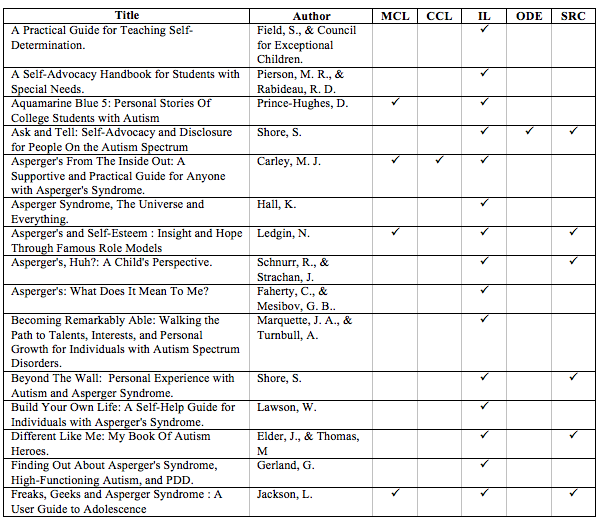
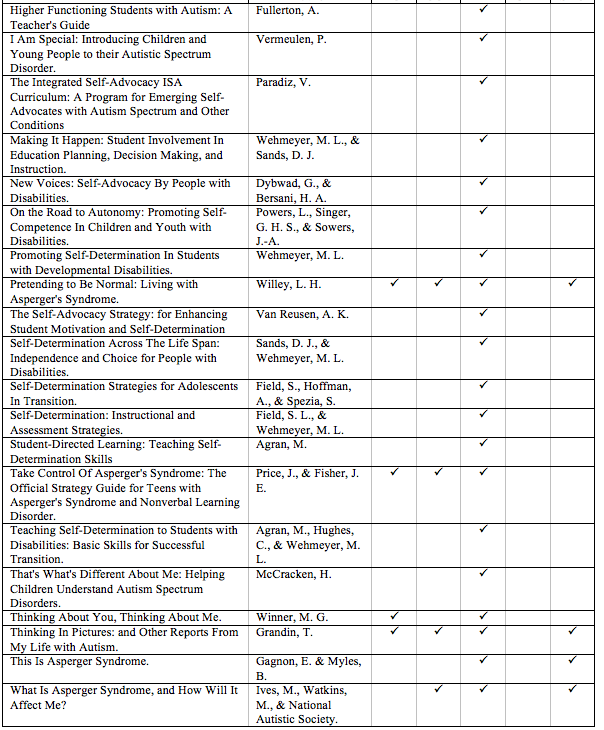
Videos

Appendix 3.5B
Checklists for Self-Determination
- Self-Setermination Checklist for Youth with ASD
- Self-Setermination Checklist for Youth with ASD and Significant Cognitive Challenges
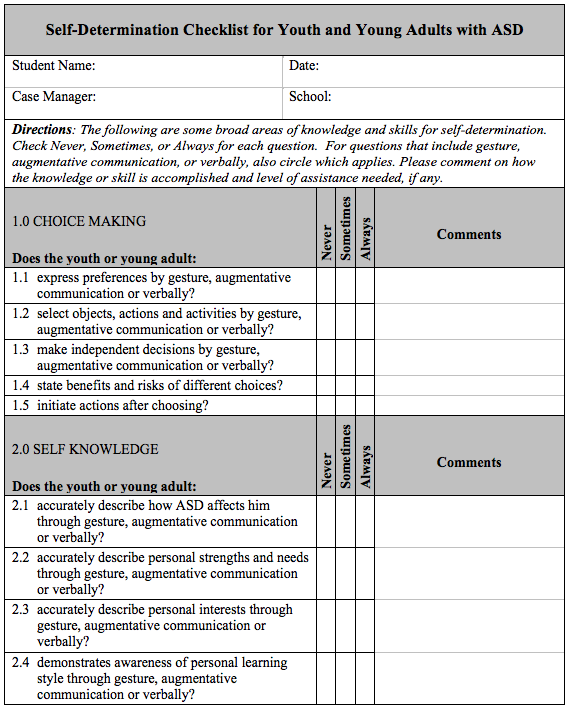
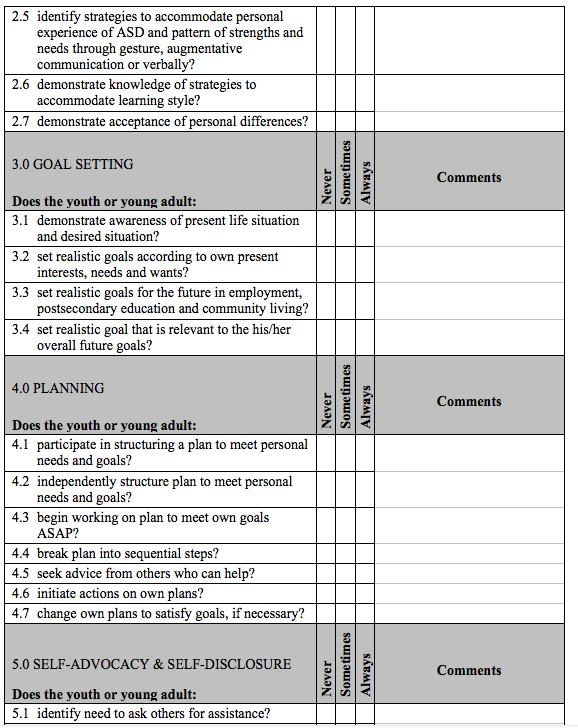
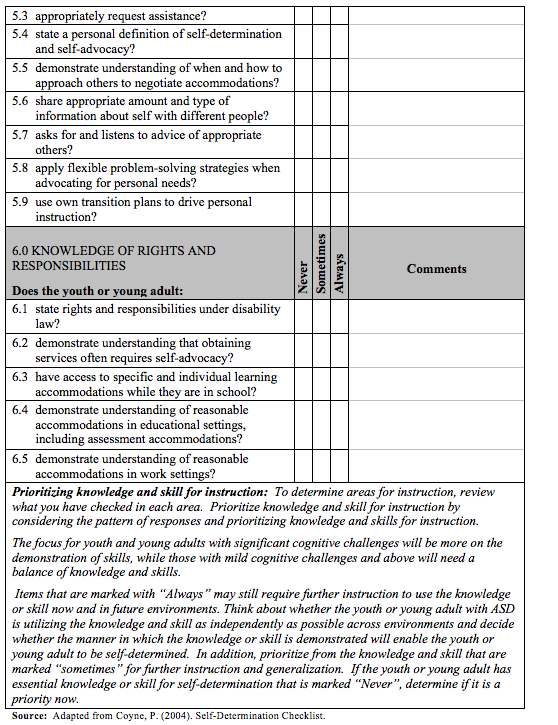
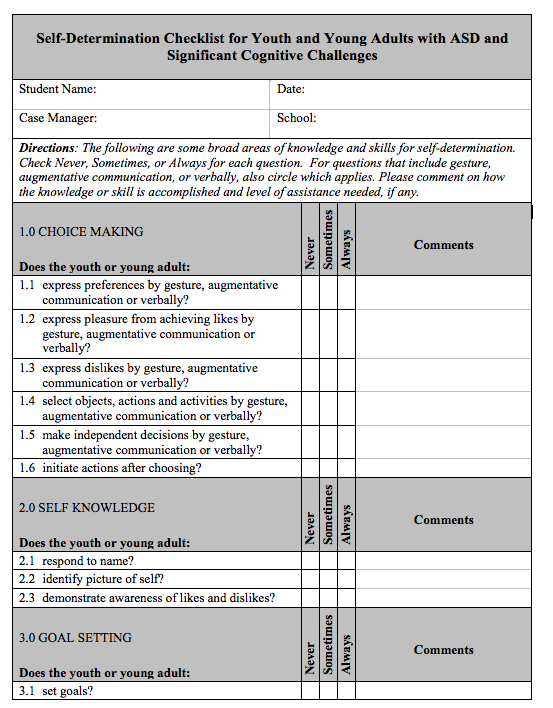
Appendix 3.5C
Supplemental Instructional Materials for Self Knowledge, Goal Setting, and Self-Disclosure
- Supplemental Instructional Materials to ‘Putting Feet on My Dreams’
- My Interests and Talents
- Three Rings of Experience
- What I Want to Tell My Family
- Lesson Plans from ‘Adjusting the Image: Focus on Social Understanding’
- Knowledge of Disability
- Understanding Own Learning Style
- Knowing About Me
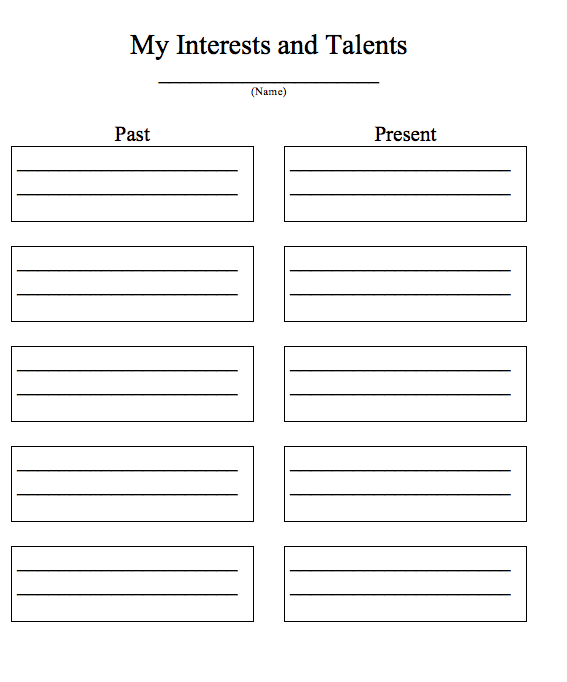
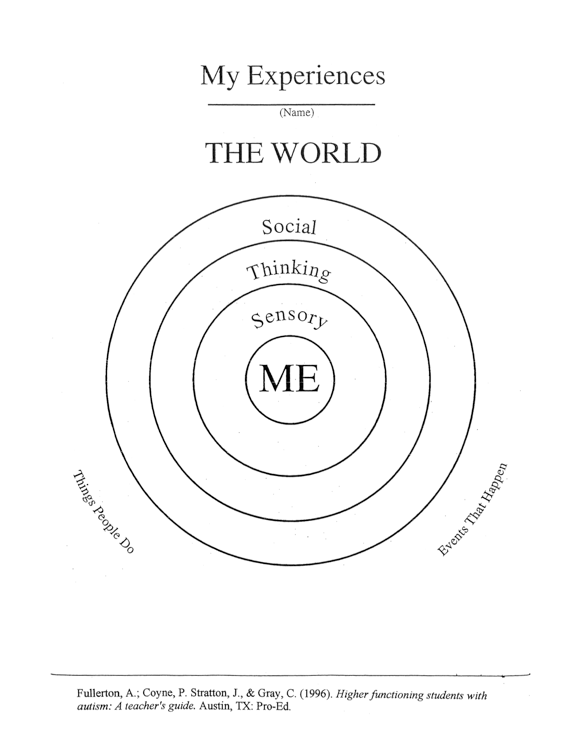
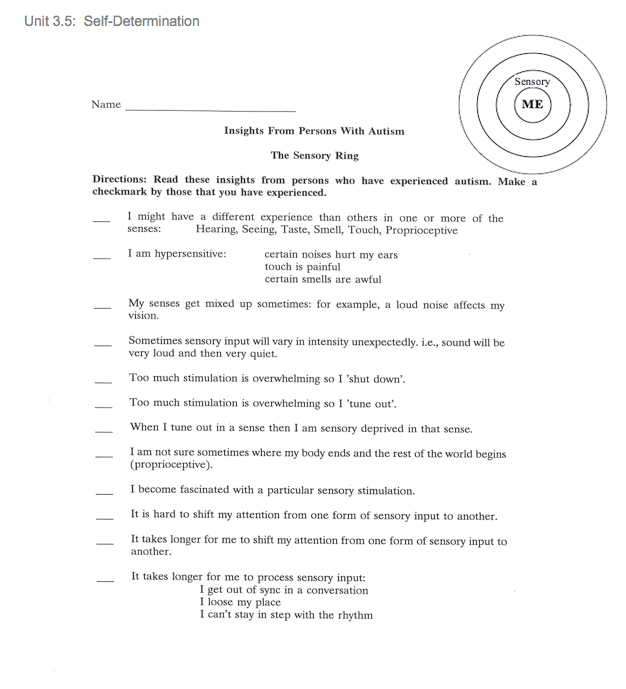
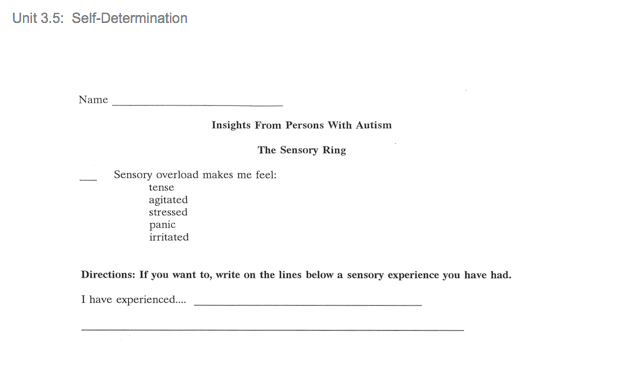
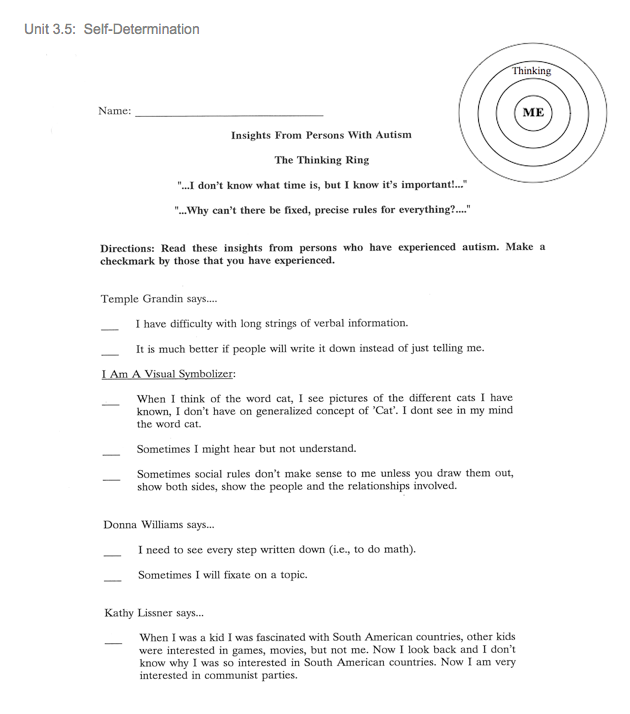
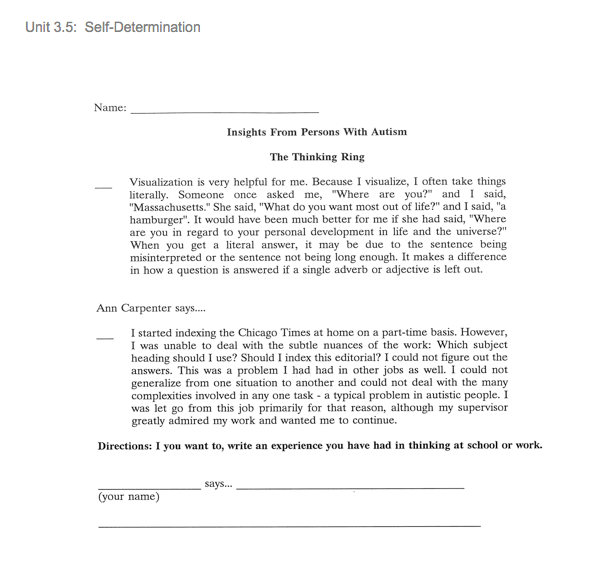
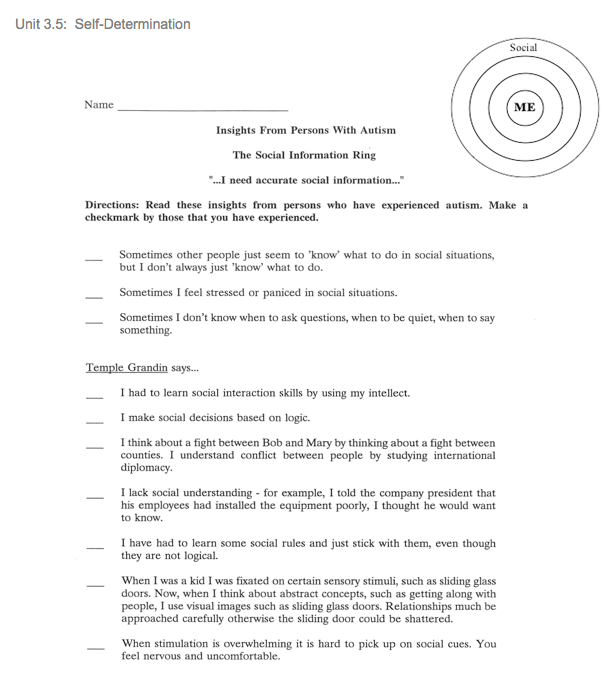
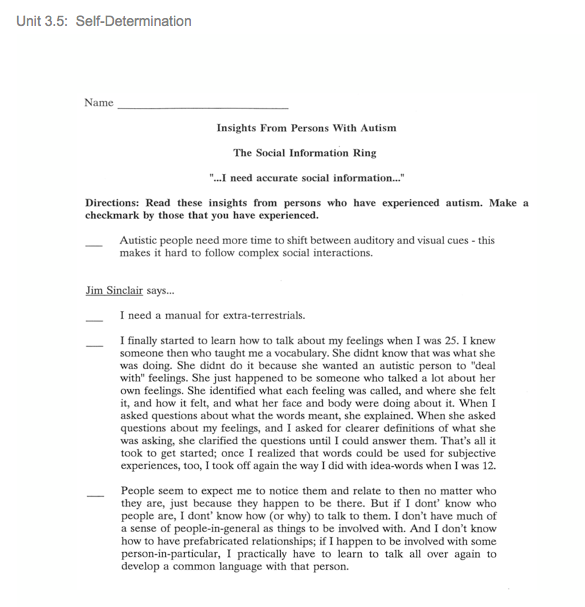
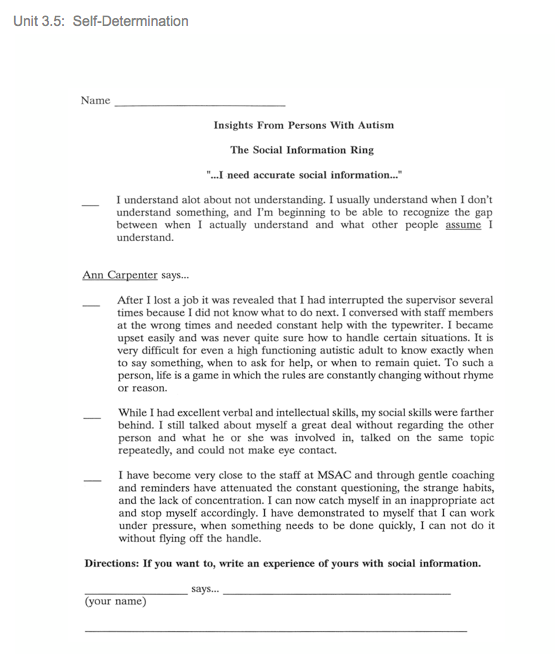
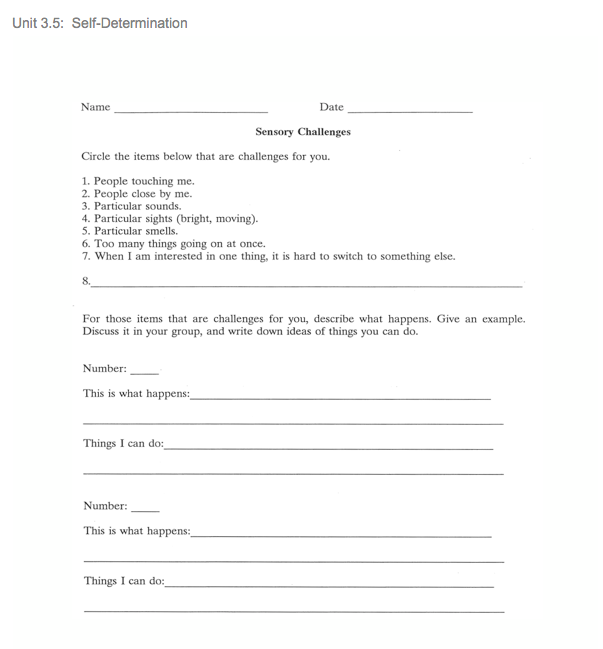
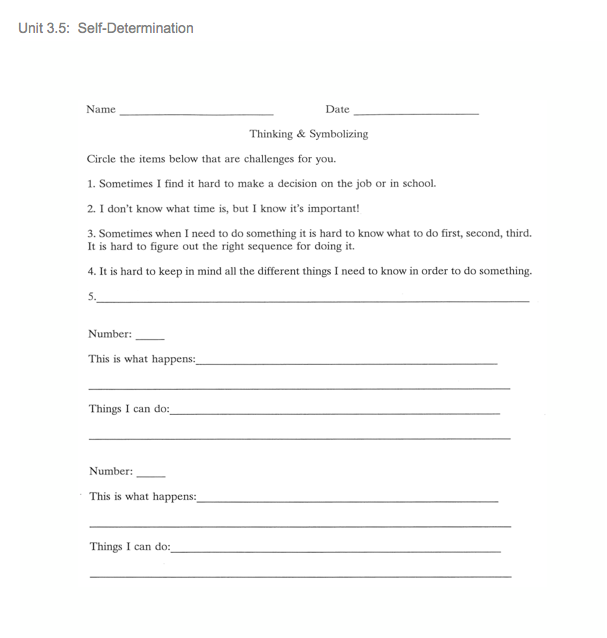
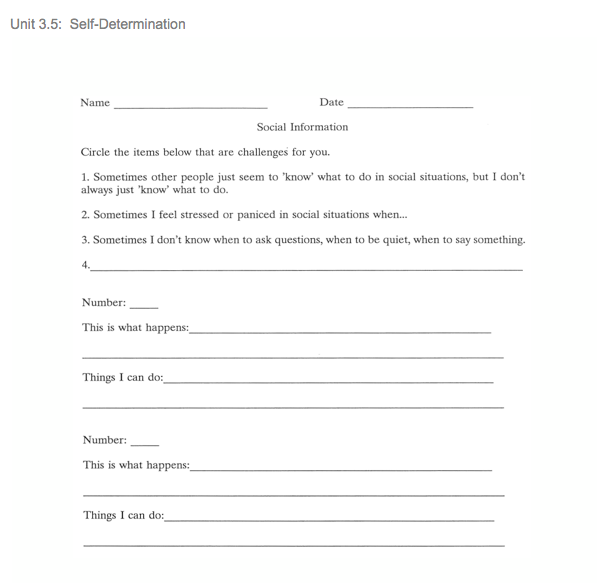
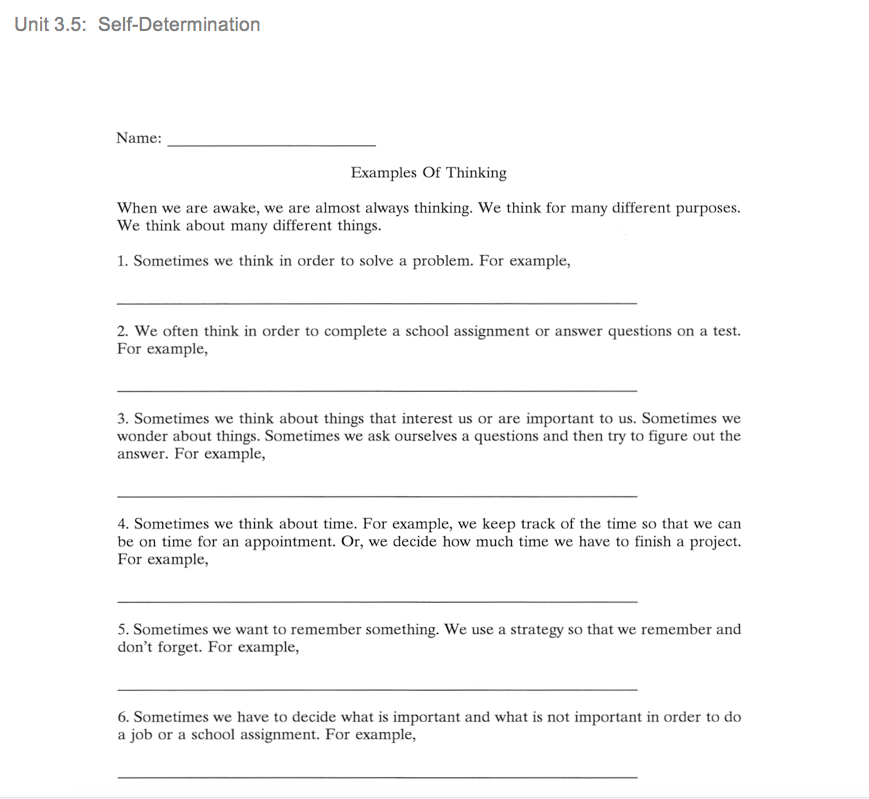
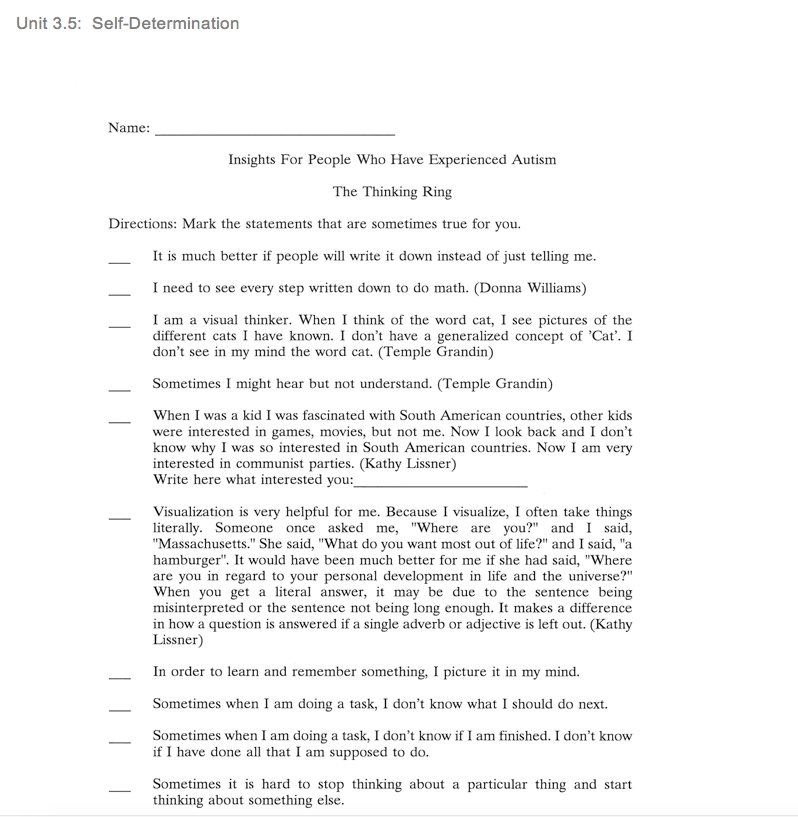
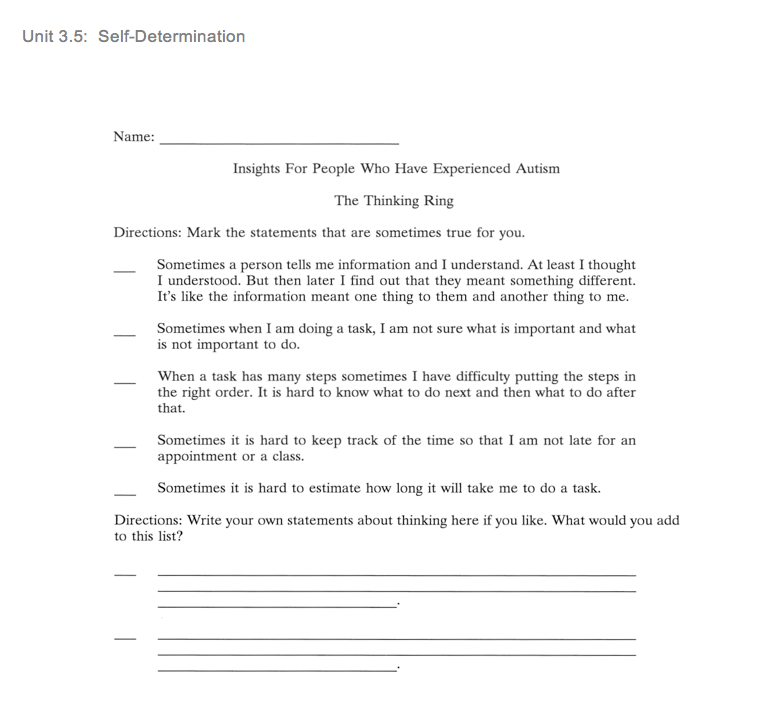
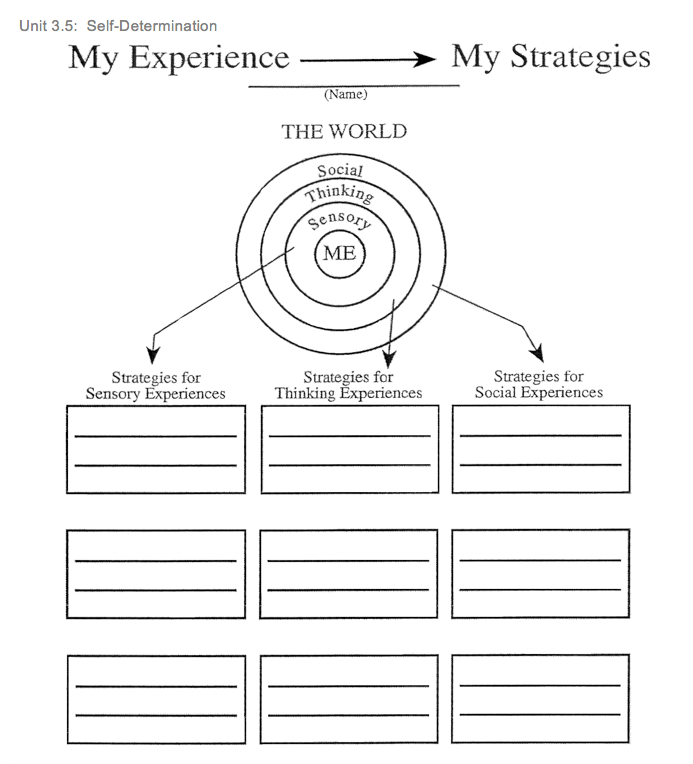
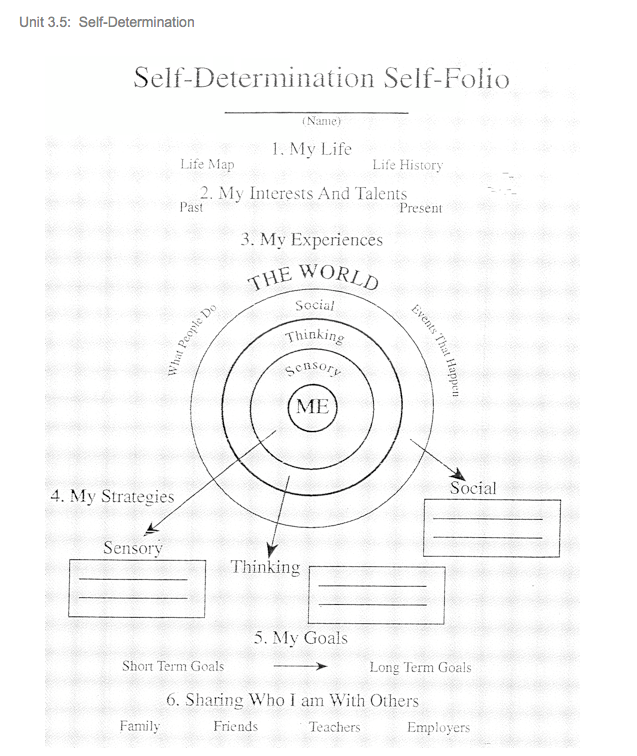
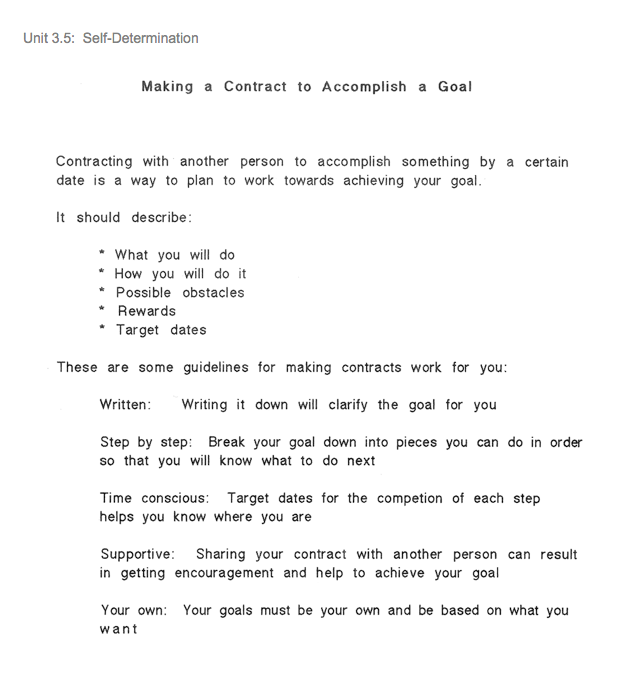
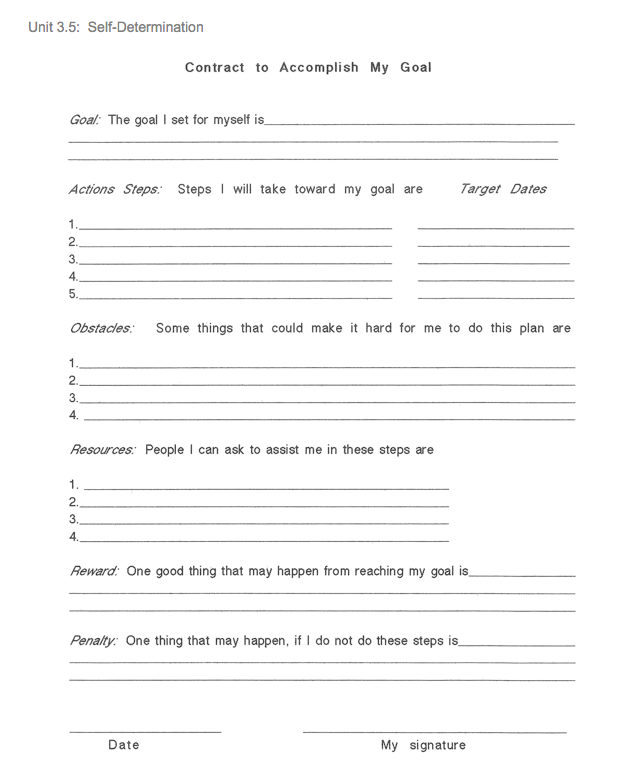
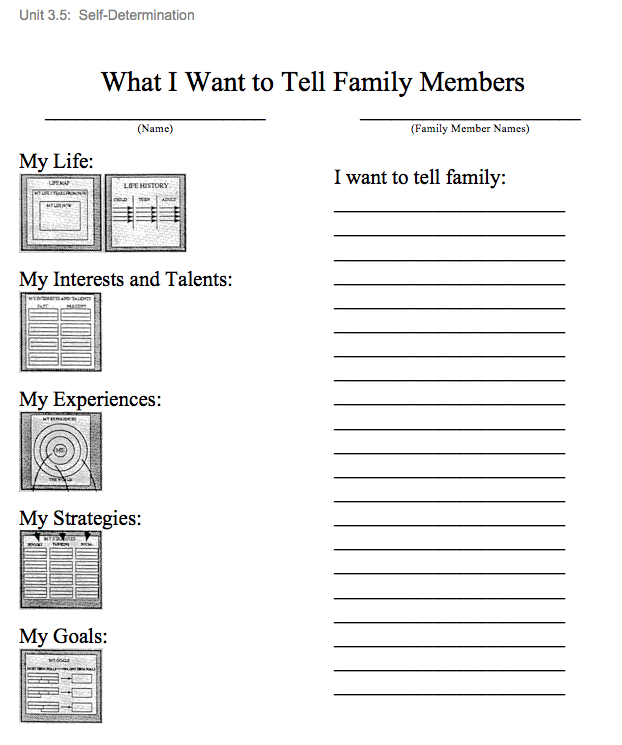
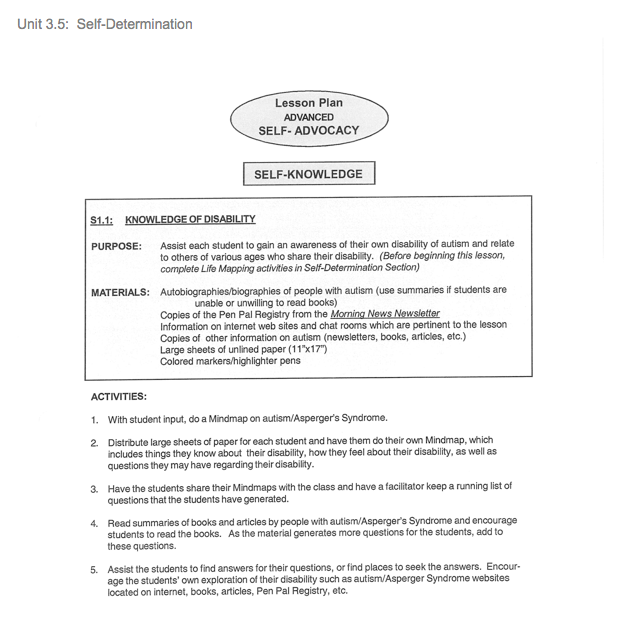
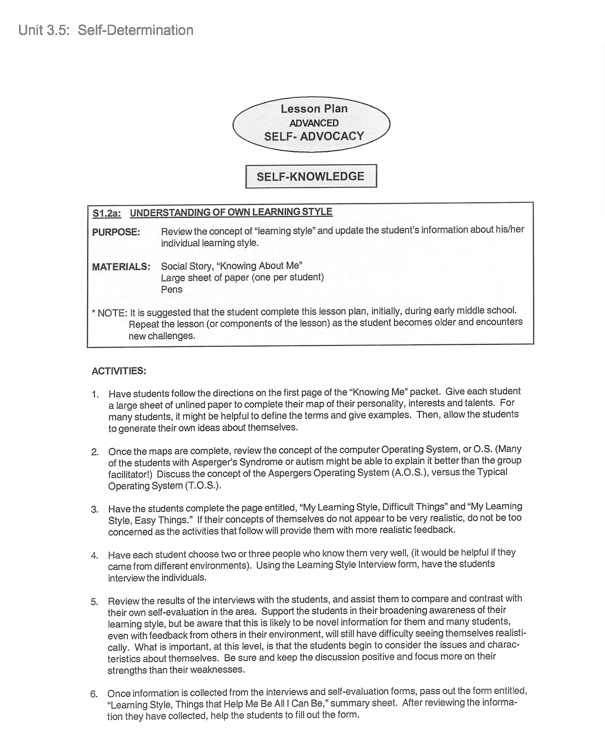
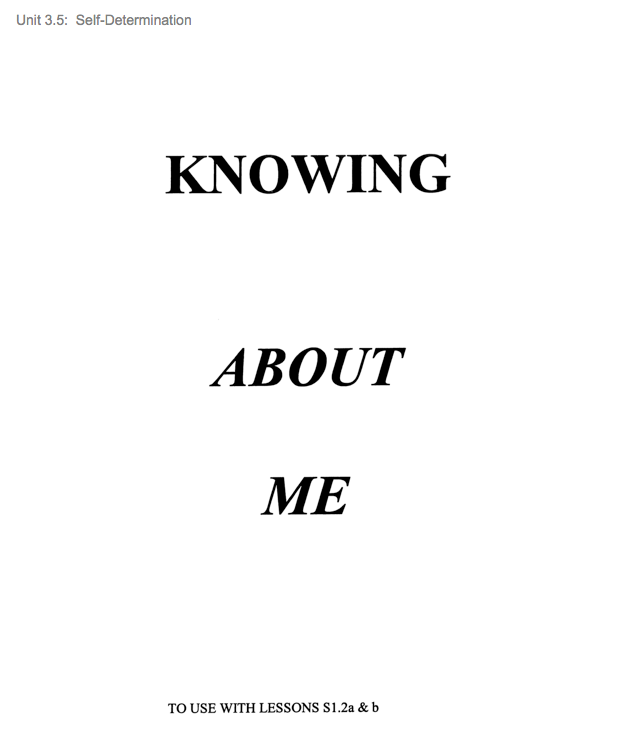
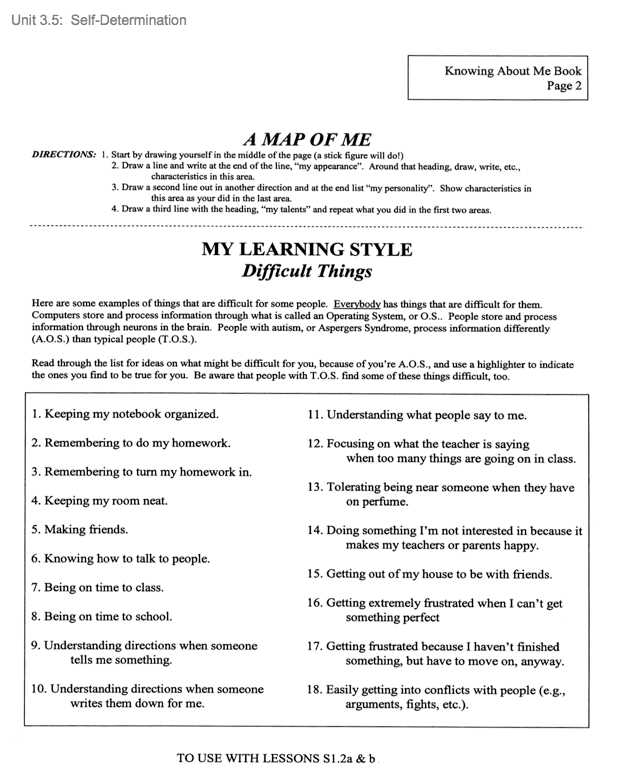
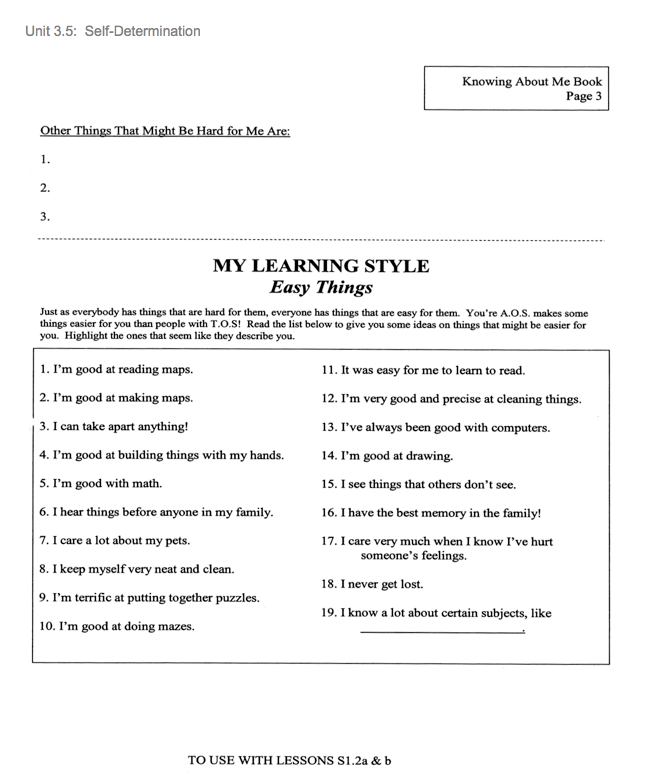
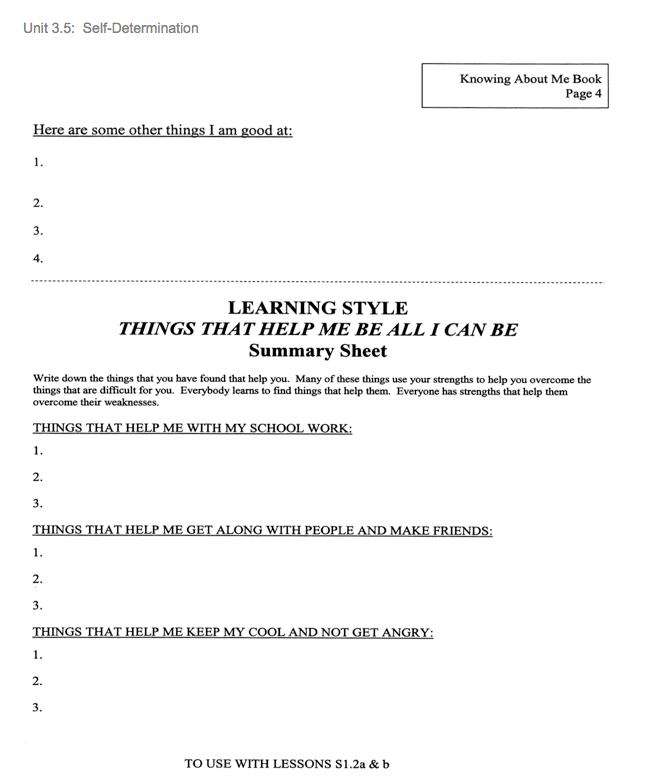
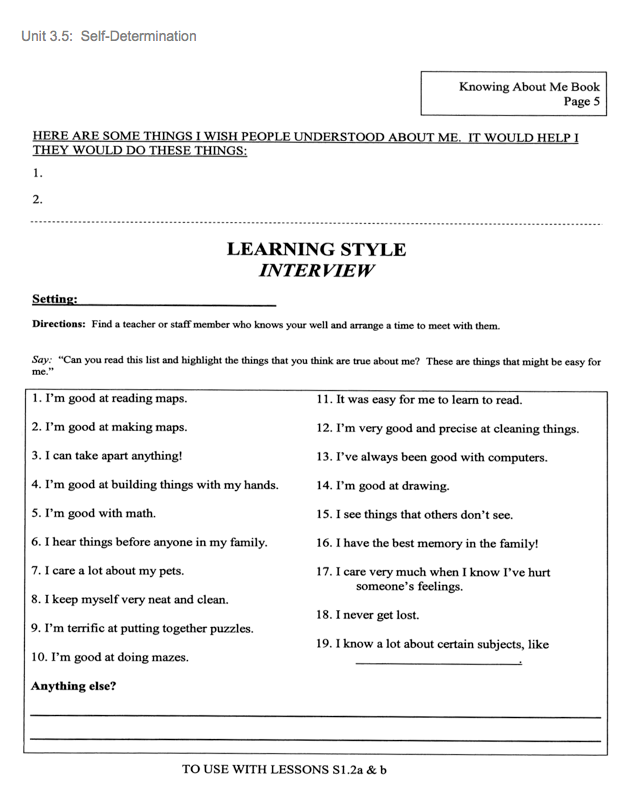
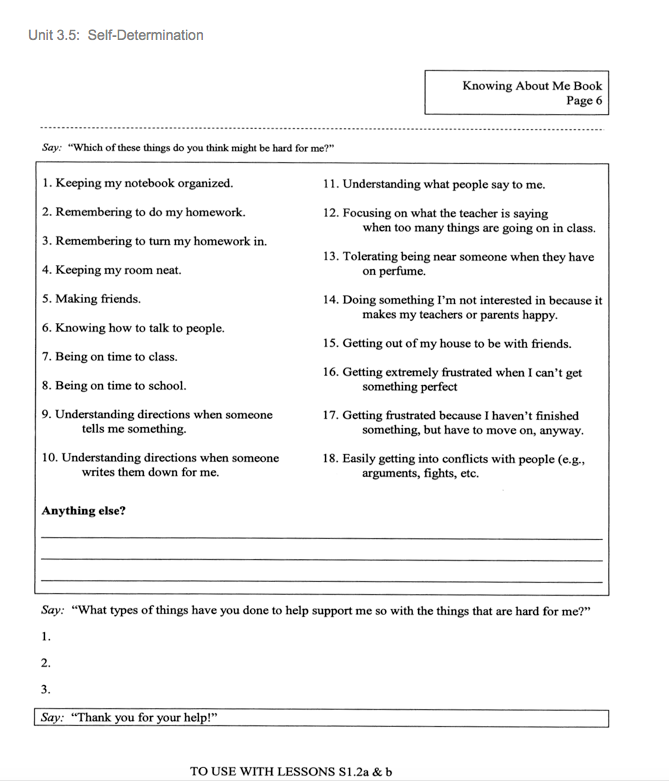
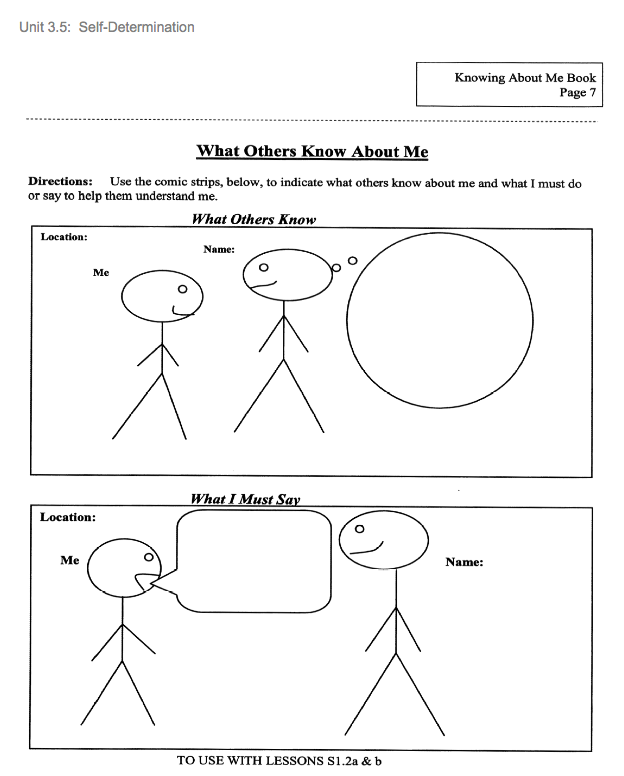
Copyright © 2016 Columbia Regional Program




